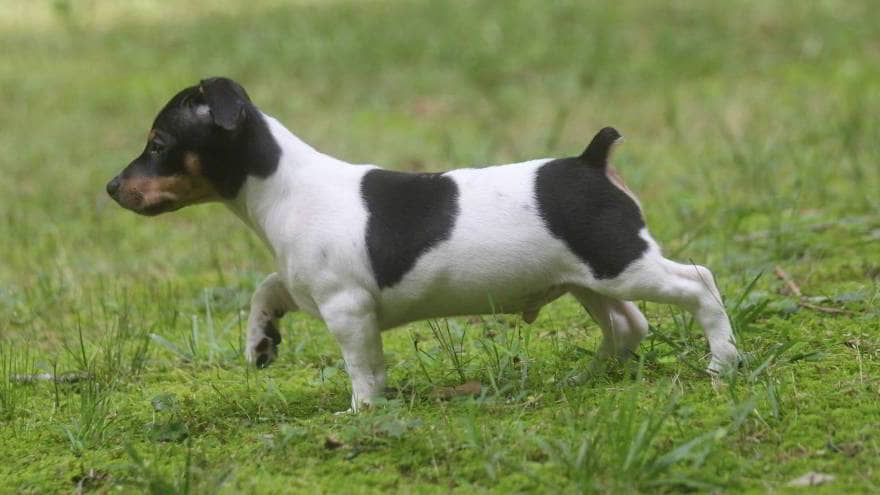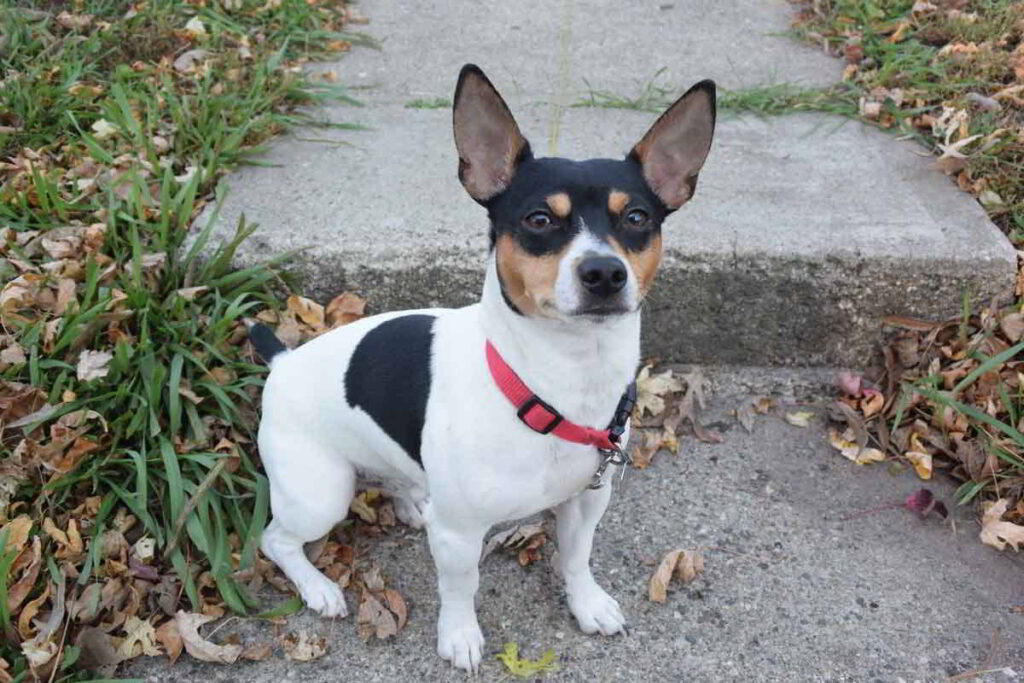Characteristics, History, Care Tips, and Helpful Information for Pet Owners
The Teddy Roosevelt Terrier is small hunting terrier named for the 26th President of the United States. The Teddy Roosevelt Terrier is closely related to the Rat Terrier, another American-bred terrier that looks much like the Teddy Roosevelt Terrier but with longer legs. Affectionately known as “Teddies,” the Teddy Roosevelt Terrier is small but feisty, with an energetic and fun-loving personality.
Teddy Roosevelt Terriers are friendly and outgoing, always ready for the next adventure. They are great family dogs and wonderful friends to respectful children who handle them gently. Thanks to their small size, Teddy Roosevelt Terriers can live happily in smaller homes and apartments so long as they get enough daily outdoor exercise. After a long day playing and exploring, Teddy Roosevelt Terriers are happy to cuddle on the couch. Unlike some terriers, Teddies tend to be dog-friendly, and even get along with much larger breeds. Some Teddies might live peacefully with cats if raised together. However, the Teddy Roosevelt Terrier has a high prey drive (the instinct to chase and kill small critters) so they can’t be trusted around smaller pets like rabbits, guinea pigs, and hamsters.

| Breed Overview GROUP: Terrier (UKC) WEIGHT: 8 To 25 Pounds HEIGHT: 8 To 14 Inches Tall At The Shoulder COAT: Short, Dense, Medium-Hard To Smooth, With Sheen COLORS: Any Bi-Color Or Tri-Color; Must Always Have Some White LIFE EXPECTANCY: 14 To 16 Years |
Characteristics of the Teddy Roosevelt Terrier
| Affection Level | High |
| Friendliness | High |
| Kid-Friendly | High |
| Pet-Friendly | Medium |
| Exercise Needs | High |
| Playfulness | High |
| Energy Level | High |
| Trainability | High |
| Intelligence | High |
| Tendency To Bark | Medium |
| Amount Of Shedding | Medium |
History of the Teddy Roosevelt Terrier
At one time, the Rat Terrier and Teddy Roosevelt Terrier were considered two varieties of the Rat Terrier breed. The longer-legged variety (today’s Rat Terrier) was known as the Type A Rat Terrier and the shorter-legged variety (today’s Teddy Roosevelt Terrier) was identified as the Type B Rat Terrier. To keep a Teddy Roosevelt Terrier from digging in places you’d rather it left alone, provide approved digging spots in certain areas of the yard. These terriers developed somewhat naturally, so we don’t have breeding records to pinpoint the exact breeds that went into their development. However, it’s thought that the ancestors of today’s Rat Terrier and Teddy Roosevelt Terrier likely included the Smooth Fox Terrier, the Manchester Terrier, the Bull Terrier, the Beagle, the Whippet, the Italian Greyhound, and the white English Terrier (which is now extinct).
In the 1990s, some breed fanciers sought to separate the Type A and Type B Rat Terriers. Their efforts led to the development of a separate breed standard for the Teddy Roosevelt Terrier and a new national club: the American Teddy Roosevelt Terrier Club. The club chose the name Teddy Roosevelt Terrier to pay homage to President Theodore Roosevelt, who owned a small terrier named Skip, which may have been a Rat Terrier or Rat Terrier mix. President Roosevelt praised Skip for keeping the White House cleared of rats and other vermin.
The Teddy Roosevelt Terrier is recognized by the United Kennel Club, where it is part of the Terrier Group. It’s part of the American Kennel Club’s Miscellaneous Class, which allows the breed to participate in performance sports while awaiting full recognition.

Teddy Roosevelt Terrier Care
The Teddy Roosevelt Terrier’s short, smooth coat sheds moderately, though regular brushing helps keep it to a minimum. You may also use a child’s sandbox filled with sand or soil. Inspect the ears weekly to look for redness, debris, or odor. Clean the ears with a pet safe ear cleaner if they become dirty and make an appointment with your veterinarian if they look inflamed, have excessive discharge, or a foul smell.
Teddy Roosevelt Terriers are athletic and full of energy. They need much more exercise than you might realize considering their small size. Daily walks or hikes are usually nice, but also consider swimming, vigorous games of fetch or Frisbee, or even training for a competitive dog sport like agility, flyball, rally obedience, or earthdog. Keep your Teddy on a leash when you are out and about. The instinct to chase and hunt small creatures is so strong, the dog could run out into traffic.
Smart, curious, and eager to please, Teddy Roosevelt Terriers can be taught almost anything. Keep training upbeat, fun, and positive, using treats or toy rewards and plenty of praise. They love to dig and will gladly keep your home and property free from rats, mice, gophers, moles, along with other vermin.
Both terrier types were small, hardy, working terriers that served the valuable function of keeping farms and homes free from rats, mice and other vermin. Bathe your Teddy Roosevelt Terrier whenever it becomes dirty and trim the nails every two weeks. Secretly bury treasures like treats, chews, and toys for your Teddy Roosevelt Terrier to find.
Common Health Problems
Although Teddy Roosevelt Terriers are generally healthy and hardy, like all purebred dogs they could be predisposed to certain genetic diseases. Issues that have been identified in the Teddy Roosevelt Terrier include primary lens luxation (a painful eye disorder that causes glaucoma), chondrodystrophy (a severe type of intervertebral disc disease), and patellar luxation (kneecaps that slip out of place). The American Teddy Roosevelt Terrier Club recommends that all Teddies have appropriate genetic tests performed, receive cardiac screenings for heart health, and have their knees examined and graded before being bred.
Diet and Nutrition
To avoid overfeeding your Teddy Roosevelt Terrier, serve measured amounts twice a day. Free feeding (leaving the bowl filled all the time) can lead to excess weight gain, which can put strain on the joints and back, and also causes other health problems like diabetes. On the flip side, some very active Teddies may need more food to fuel their bodies. If you’re not sure how much to feed talk to your veterinarian or breeder for advice.
Pros
- Great family dog
- Affectionate and engaging
- Kid friendly and dog friendly
Cons
- May dig up the yard
- Needs lots of exercise
- High prey drive/not safe off leash

Where to Adopt or Buy a Teddy Roosevelt Terrier
The Teddy Roosevelt Terrier is a relatively new and rare breed, so it might be hard to find a breeder who has puppies available. The American Kennel Club provides a list of member breeders on its website. Be prepared to get on a long wait list. If you wish to adopt, some Teddy Roosevelt Terriers or Teddy mixes might end up in local animal shelters and through private rescue groups.
More Dog Breeds and Further Research
If you like the Teddy Roosevelt Terrier, you might also like these breeds:
- Jack Russell Terrier
- Parson Russell Terrier
- Rat Terrier
Otherwise, check out all of our other dog breed articles to help you find the perfect dog for you and your family.
